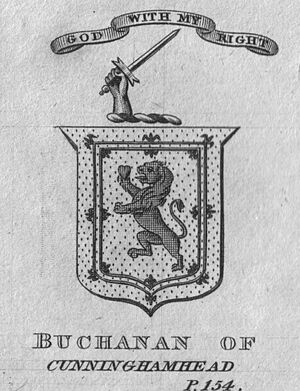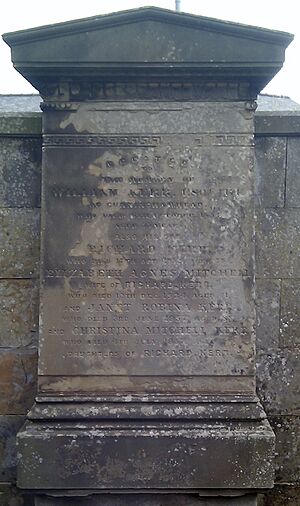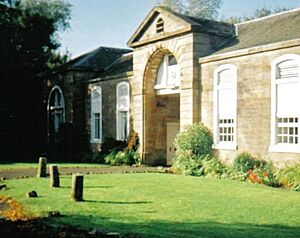Cunninghamhead Estate facts for kids
Quick facts for kids Cunninghamhead Estate Caravan Park and Stables. |
|
|---|---|
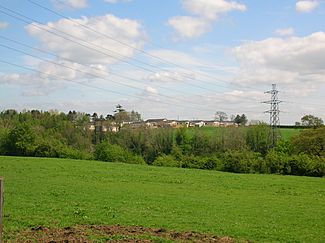
Caravan park and housing at the site of old Cunninghamhead House.
|
|
| Type | Residential Park |
| Location | Cunninghamhead Estate, Irvine, Scotland |
| Area | 18 acres |
| Visitors | No |
| Status | Private |
| Public transit access | Cunninghamhead railway station |
Cunninghamhead Estate is mostly a residential caravan park today. It also has two private homes near Irvine, Scotland. This area was once a large private estate. Different families owned it since about 1418.
The main house, built in 1747, was one of Britain's lost grand homes. It burned down in the early 1960s during renovations. The old mansion and castle are gone. However, the stables are now a home. The Gardener's Cottage is still there as ruins.
From 1964, the estate was first used as a chicken farm. Later, it became a holiday and residential caravan park and camping site. This made the most of its countryside location. Around 2003, the site was updated a lot. It became a caravan park just for retired and semi-retired people.
Contents
Discovering Cunninghamhead's Past
The area was first called Woodhead. Its name changed to Cunninghamhead before 1418. A old document from 1346 mentions Godfrey de Ross as being 'of Coyninghamheid'. The Cuninghame family took over these lands in the early 1400s. This happened when Robert Cuninghame married the Douglas heiress of the estate. From then on, the family leader was known as the Laird of Cunninghamhead.
Old maps show the name 'Cuningham Head' in 1654 and 'Rungham' in 1745. Cunninghamhead Castle was a square tower. People called it a "strong old donjon," which meant a strong tower. John Snodgrass tore it down in 1747. He then built a new mansion house. The estate cost John Snodgrass Buchanan a lot of money when he bought it in 1728.
When it was built, Cunninghamhead House was thought to be one of the prettiest homes in the country. But by 1823, it had been changed. It had lost some of its original beauty. A map from 1811 shows the new mansion. It also shows the castle ruins behind it.
Who Owned Cunninghamhead?
The Cunninghame family owned these lands for many centuries. Then the Snodgrass family bought them. In 1823, the Buchanans of Craigievairn owned the estate. Mr. Snodgrass Buchanan was the owner in 1838. The Kerr family followed them. In 1951, the Misses Kerr were recorded as owning the estate.
Middleton was also part of the estate. Around 1564, the name was 'Cunnygahamehead'. The laird also owned Powkellie, now Pokelly, near Stewarton.
Cunninghamhead Moss was still called Kinnicumheid Moss in the 1700s. An old Scottish story says a warlock (a male witch) from Auchenskeith, near Dalry, made the Devil build a road across Kinnicumhead Moss in one night. This story links to how Cunninghame was once pronounced, closer to 'Kinikam'.
Important Cunninghame Family Members
Many generations of the Cunninghame family lived at Cunninghamhead. Sir William and his brother Sir John were very important. Sir William was at the Great Parliament of 1560. He strongly supported John Knox's changes. These changes led to the "end of popery" in Scotland. Sir John was part of the General Assembly in 1565. This group was not liked by those who followed the old religion at that time.
The Highland Hosts' Visit
In the 1640s, Alasdair Mac Colla was sent by Montrose. His job was to stop support for the Covenanters. He took things from the Ayrshire countryside for days. Then he demanded money. Sir William Cunningham had to pay a large sum for Cunninghamhead. The estate had already suffered a lot of damage.
Later, in 1678, another group of soldiers, mostly Catholic Highlanders, came to Ayrshire. They were sent by the King to stop public meetings held by Presbyterians. At Cunninghamhead, where Sir William Cunninghame lived, these Highlanders stayed for a month. They ate and destroyed food in the granary. They used fire to open locked places. A soldier even threatened a farmer to get money.
People reported that the soldiers took what they wanted. They robbed people on the roads. They hurt those who complained. They stole and destroyed animals. They even used fire to make people tell them where money was hidden. They threatened to burn houses if they didn't get what they wanted. They also demanded money every day. They even made poor families buy them drinks and tobacco. They hurt people just for fun. All this cost a lot of money in the local area.
A Family Dispute at Towerlands
On December 19, 1600, William Cuninghame of Towerlands (near Bourtreehill) was accused of serious actions. His brother, Alexander, with hired soldiers, had taken over Cunninghamhead House in March 1600. The King had told them in writing to leave. But they fought against the King's officials. William Cuninghame of Towerlands was found guilty of helping his brother. He was punished, and all his lands and goods were taken away.
The Snodgrass Family's Time
John Snodgrass bought the estate in 1728. In 1747, he pulled down the old tower-house and built the mansion. Neil Snodgrass built the stables. He also made the mansion house bigger or rebuilt it. Neil Snodgrass started studying law in 1755. But his eyesight was badly hurt by smallpox. So he had to return to the countryside. He focused on farming. He became good friends with Alexander, Earl of Eglinton. They worked together to improve farming, like using crop rotations. In 1773, he married Marian McNeil. They had six children.
In 1811, Mr. Snodgrass was praised for his efforts in farming. He followed the example of the Earls of Eglinton and Loudoun. The Snodgrass family symbol showed a figure of justice holding a balance. Their motto was "Discite Justinian" (Learn Justice). The lands of Cunninghamhead were valued at £330 in 1640. William Kerr Esq of Cunninghamhead was buried in Dreghorn Parish churchyard.
Mr and Miss Buchanan of Cunninghamhead went to the famous 1839 Eglinton Tournament. This event was held in what is now Eglinton Country Park. They had a special seat in the Grand Stand.
The Kerr Family Takes Over
Hugh Kerr of Gatend Farm near Barrmill died in 1818. His wife died soon after. Hugh had three sons, William, Robert, and Hugh. They moved to America and became very rich. William Kerr bought Cunninghamhead. He lived there after he retired until he died in 1853. His only child, Richard, took over the estate after him.
Cunninghamhead Today
The Mansion House Story
A developer bought the old mansion house after the Kerr sisters died. The renovations were almost finished. But then, people broke in and the building was destroyed by fire. The fire happened in the early 1960s. The house was too damaged to fix, so it was torn down.
The Caravan Park Today
By the 1960s, the estate was quite run down. The main road was even hard to walk on. From 1964, work began to use the estate as a chicken farm. Later, it became a caravan park and camping site. From 2003 onwards, the caravan park was greatly updated. It became a residential park only for retired and semi-retired people.
The Wigwam Bar
In the 1980s, a big building was added to Cunninghamhead Estate. This was the Wigwam Bar. The bar served the caravan site. It also hosted events for local young farmers. Around the year 2000, the bar was changed into two holiday homes for rent.
The Cottage Ornée Mystery
An unusual old building stands as a ruin by the Annick Water river. It's in a flat area on the southern bank. A path through the woods connects it to the stables and where the old mansion house was. This building's remains are made of large river stones at the bottom. It also has well-cut sandstone blocks. It had a big window and door facing the flat area. The wall facing the river has mostly fallen down. It might have had two large windows. The door has been carefully blocked. The window facing the flat area might have been made into an entrance.
The building is quite small. This suggests it might have been a "Summer House" or a "Cottage ornée". These were popular in the early days of the estate, around 1747. The last person who lived there was a Mr. Mackay, who was a poet or writer. Charles Mackay was an editor for a newspaper called the Glasgow Argus for four years from 1844. He later moved back to London. Another Charles Mackay, an actor and writer, lived in the early 1700s.
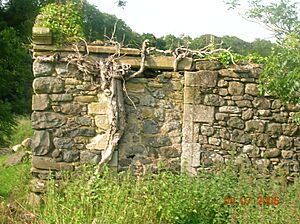
An old description of a similar building in the Eglinton Estate might have inspired this one. It says: "Near the gardens, in a quiet corner, almost surrounded by the river, a very pretty cottage was built. Lady Jean Montgomery designed it. She made it neat and simple, but also very tasteful. This kind lady sometimes spends her free time at this lovely cottage. She enjoys looking at nature's beauty and thinking about how plants grow." Lady Jane Hamilton, the Earl's Aunt, built or made 'Lady Jane's Cottage' bigger. It was next to the Lugton Water. She used this building to teach peasant girls how to manage a home. This might be a later use for Lady Jane's cottage.
The Gardener's Cottage
The Gardener's Cottage was at the end of the road leading to the river. It was a large building. It had been made bigger at least once. But after a lot of damage from vandals, it was torn down in the mid-1980s.
The Estate Stables
The main stable building has an impressive front. It probably also held the estate offices. This part dates from 1820. The rest might be from the 1740s. Some small workers' homes were at the bottom of the courtyard. You can see where their doors were blocked up. At the front of the stables are three small stone columns. These were used to help riders get on their horses. These Cunninghamhead mounting stones were put there by a past owner. They are not original to the building.
A small doocot or dovecot was above the entrance arch. It was removed by the current owner. Doocots were common on many estates. Only major landowners were first allowed to build them. Later, smaller landowners could build them. Sometimes, tenants could get permission from their landlord. Doocots were used for meat or to make the property look nice.
The stables were put up for sale in 2008. They were sold in mid-2015. The new owner has submitted big plans for development.
Other Old Buildings
You can also find the ruins of other old buildings in the woods. These are known as the 'Gardener's Cottage'. They are completely ruined now. They are off to the left of the path leading down to the Annick Water. Quarry Holm is next to the old railway track. It's between the estate and Annick Lodge. Here, you can find the foundations of some old buildings. They seem to have been industrial buildings. They were used again before being left empty. The railway line, built in 1843, cut this area off from Annick Lodge.
Nature at Cunninghamhead
Some parts of the woods on the north side of the Annick Water are very old. They have many different kinds of plants. This shows they are not just new tree plantings. These woodlands have plants like Male Shield Fern, Lady Fern, Tuberous Comfrey, Tussock Grass, Bluebells, Dog's Mercury, Opposite-Leaved Golden Saxifrage, Woodrush, Sanicle, Enchanter's Nightshade and Wood Sorrel. Agrimony is another unusual plant found here. It grows by the Annick Water river bank, along with wild mint. These plants are just upstream of the old railway bridge.
Images for kids


